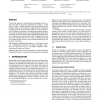Free Online Productivity Tools
i2Speak
i2Symbol
i2OCR
iTex2Img
iWeb2Print
iWeb2Shot
i2Type
iPdf2Split
iPdf2Merge
i2Bopomofo
i2Arabic
i2Style
i2Image
i2PDF
iLatex2Rtf
Sci2ools
SIGGRAPH
1997
ACM
1997
ACM
Anatomy-based modeling of the human musculature
Artists study anatomy to understand the relationship between exterior form and the structures responsible for creating it. In this paper we follow a similar approach in developing anatomy-based models of muscles. We consider the influence of the musculature on surface form and develop muscle models which react automatically to changes in the posture of an underlying articulated skeleton. The models are implemented in a procedural language that provides convenient facilities for defining and manipulating articulated models. To illustrate their operation, the models are applied to the torso and arm of a human figure. However, they are sufficiently general to be applied in other contexts where articulated skeletons provide the basis of modeling. CR Categories and Subject Descriptors: I.3.5 [Computer Graphics]: Computational Geometry and Object Modeling Surfaces and Object Representations; I.3.7 [Computer Graphics]: ThreeDimensional Graphics and Realism.
| Added | 07 Aug 2010 |
| Updated | 07 Aug 2010 |
| Type | Conference |
| Year | 1997 |
| Where | SIGGRAPH |
| Authors | Ferdi Scheepers, Richard E. Parent, Wayne E. Carlson, Stephen F. May |
Comments (0)

